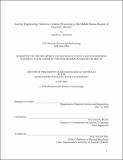| dc.contributor.advisor | Dorothy Hosler. | en_US |
| dc.contributor.author | Meanwell, Jennifer L. (Jennifer Lauren) | en_US |
| dc.contributor.other | Massachusetts Institute of Technology. Dept. of Materials Science and Engineering. | en_US |
| dc.coverage.spatial | n-mx--- | en_US |
| dc.date.accessioned | 2009-07-01T16:59:43Z | |
| dc.date.available | 2009-07-01T16:59:43Z | |
| dc.date.copyright | 2008 | en_US |
| dc.date.issued | 2008 | en_US |
| dc.identifier.uri | http://dspace.mit.edu/handle/1721.1/44388 | en_US |
| dc.identifier.uri | http://hdl.handle.net/1721.1/44388 | |
| dc.description | Thesis (Ph. D.)--Massachusetts Institute of Technology, Dept. of Materials Science and Engineering, 2008. | en_US |
| dc.description | This electronic version was submitted by the student author. The certified thesis is available in the Institute Archives and Special Collections. | en_US |
| dc.description | Includes bibliographical references (v. 2, p. 343-355). | en_US |
| dc.description.abstract | Previous experimental research into ancient pottery production has proven that potters can produce vessels with varying materials properties, such as thermal shock resistance and permeability. These properties are differentially useful for certain tasks, such as cooking or water-cooling. In certain cases, such as the use of shell temper in North America, an improvement in thermal shock resistance seems to provide an explanation for why the new temper was adopted along with the introduction of a new food type -- maize. It remains an unanswered question, however, whether potters in a large variety of situations were choosing to alter their production techniques or materials to produce pots intended for different functions that exhibit different materials properties. I investigated this question by applying techniques and concepts from materials science, anthropology, and archaeology. This combination of materials science and social science was pioneered by Heather Lechtman and Dorothy Hosler, and is called the "materials approach." My research focuses specifically on pottery production in the Middle Balsas Region of Guerrero, Mexico, from approximately 300 BC to AD 1300. I investigated whether potters in the Middle Balsas were using different production techniques or raw materials for vessels that were intended for specific functions. I chose the Middle Balsas Region as the geographical focus for my research because little systematic archaeological investigation has focused on that area, especially in the Late Preclassic and Classic periods (300 BC-AD 900). In order to gather appropriate data, I mapped, surface collected, and excavated at three Middle Balsas sites. I then categorized the pottery and analyzed a selected portion via thin section analysis/petrography. | en_US |
| dc.description.abstract | (cont.) The combination of field work and laboratory analyses that I used provided me with data on the production techniques practiced by Middle Balsas potters and allowed me to identify what wares and vessel shapes were characteristic of various time periods. I determined that Middle Balsas potters produced a consistent set of wares and vessel shapes made from a variety of clay sources, and that the clays I identified in their vessels always contained a consistent volume fraction of non-plastic inclusions. The majority of the clays used in these vessels naturally contain the high levels of non-plastic inclusions identified. When the clays did not contain this volume fraction of inclusions, the potters added a sand temper to the clays to reach their "ideal" volume fraction. The consistency that I identified in the production of Middle Balsas pottery lasted over one thousand years, which is unusual in Mesoamerica. I suggest that this production pattern may have occurred because a small number of potters who used a specific, shared technique made the vessels for the entire community. | en_US |
| dc.description.statementofresponsibility | by Jennifer L. Meanwell. | en_US |
| dc.format.extent | 2 v. (480 p.) | en_US |
| dc.language.iso | eng | en_US |
| dc.publisher | Massachusetts Institute of Technology | en_US |
| dc.rights | M.I.T. theses are protected by
copyright. They may be viewed from this source for any purpose, but
reproduction or distribution in any format is prohibited without written
permission. See provided URL for inquiries about permission. | en_US |
| dc.rights.uri | http://dspace.mit.edu/handle/1721.1/44388 | en_US |
| dc.rights.uri | http://dspace.mit.edu/handle/1721.1/7582 | en_US |
| dc.subject | Materials Science and Engineering. | en_US |
| dc.title | Ancient engineering : selective ceramic processing in the Middle Balsas Region of Guerrero, Mexico | en_US |
| dc.type | Thesis | en_US |
| dc.description.degree | Ph.D. | en_US |
| dc.contributor.department | Massachusetts Institute of Technology. Department of Materials Science and Engineering | |
| dc.identifier.oclc | 277139622 | en_US |
